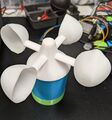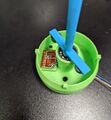Human Comfort Sensor
This project is an attempt in creating a low cost weather station sensors in order to measure the level of human comfort in that area. The sensors are compossed of wind speed sensors, black globe temperature sensors, temperature & humidity sensors
Wiring diagram and program code : Human_Comfort_Supplementary
Contents
Windspeed Sensor progress
DC motor prototype
We tried to build a windspeed sensor from scratch, the first sensor are make using DC motor as a base. The idea is we will have the wind to turn the propeller that are attached to the dc motor and have the motor act as a generator. Turns out this method is not viable to be use for windspeed sensor application as the motor have a stall torque that are preventing it to turn when the windspeed is below 1 m/s.
Hall effect protoype
For the second prototype we tried to use a more popular method to measure windspeed which is to use a hall effect sensor and magnets. The sensor works by having the hall effect sensors to trigger when there's magnet on top of them and the hall effect sensor measure count the amount of time the magnet triggers the sensors.
Early prototype shows promise as this method could handle with low wind speed measurement as the only thing that could cause kept it from turning is the smoothness of the bearing. Sadly we don't go forward with this method as our users prefer to go with premade one as they have concern with the build quality of the 3D printed material. Although there are other 3D printer filament that could go against sunlight degradation, we need a long term testing to be sure as such we are not going to continued with this setup.
QS-FS Sensor
Since the 3d printed option is not viable for this application, we tried to use the one that are available in the market and found this windmeter sensor. The version that we use is the one that gave the output of 0-2 Volt but the input voltage is at 12V. After dissassembling the 12V apparently just ensure the voltage stability and if we remove that module we could make the sensor run in a lower voltage and even run in 3.3v albeit changing a bit in how the original analog readout calculation.
Black globe temperature sensors
We tried to make this buy getting a copper ball coated in black paint that are used for floats and put in a heat sensor inside. Later we'll compare the data that are gotten from the readout to an actual black globe thermometer to ensure the quality of the data.
Temperature & humidity Sensors
Weather shield testing
Testing the weather shield that we bought and the previous one that we have gotten from melbourne uni to see if theres any major effect on the different material it have. We put all 3 types of temperature & humidity sensors and have it compared to a standard instrument that are used for actual weather station monitoring.


